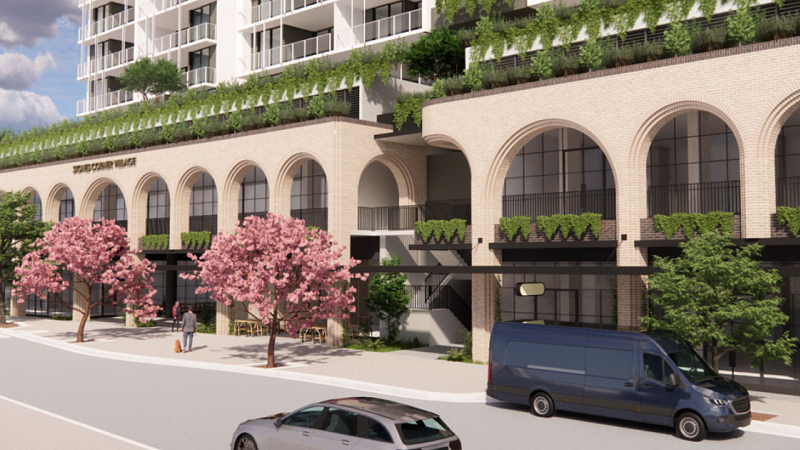A growing number of developments are replicating one of Brisbane’s most luxurious precincts – even in working-class suburbs.
A growing number of developments are replicating one of Brisbane’s most luxurious precincts – even in working-class suburbs.
- Perspective
- National
- Queensland
- City life
By Courtney Kruk
February 5, 2025 — 7.21pm
There’s no denying Stones Corner is due for an upgrade.
While the suburb has its own thing going on – visit local bar Shady Palms for Wednesday night trivia to see – it’s a textbook case for urban renewal. It’s close to the CBD and public transport, in a growing area, and slightly rough around the edges.
So Brisbane City Council’s plan for Stones Corner’s revival, released in October, isn’t a surprise.

“In the same way we are helping to transform Teneriffe, Howard Smith Wharves and West Village in West End, our Suburban Renewal Precinct Program will ensure suburbs throughout Brisbane get even better,” Lord Mayor Adrian Schrinner writes in the introduction.
The following month, the council approved a development application from Stockwell for Stones Corner Village on Logan Road, where Aldi is now. It included 209 apartments across two towers and a new mixed-use precinct with retail and commercial space.
What struck me wasn’t the housing density and freshen-up, but how similar the renders look to Fortitude Valley’s James Street Precinct.
Is this the upgrade Stones Corner, a suburb with a strong working-class history now mostly home to low-to-middle income earners, needs?

The brick archways and breeze-block facades of James Street are about more than just architectural trends: they’ve come to represent luxury.
Advertisement
Loading
Just ask Cox Architecture, the firm behind a proposal for 88 Robertson Street in Fortitude Valley that references James Street’s “strong brand and image … continuing into other streets in the area”.
A block away from James Street, luxury makes sense. But to transform Stones Corner in the same way risks rapid gentrification.
Will redevelopment push residents out of the suburb where they’ve made their homes? And if it doesn’t, how will they interact with the space?
There are people who feel welcome on James Street, and many more who don’t.
Urban sociologist and University of Queensland professor Peter Walters says architecture can create social barriers – as it has in the West Village development.
“If you look at Boundary Street and West End, which has a very diverse community including homeless and Indigenous people, they would be made to feel very unwelcome [in West Village] on a number of levels,” Walters explains.

After community angst over the initial plans for that precinct, then deputy premier Jackie Trad negotiated extra public space with the developer, Sekisui House.
“It was meant to provide an interface with Boundary Street, but the developer just planted that out with about 80 per cent of impenetrable garden,” Walters says.
“The developer has also put a lot of money into studies about how to sanitise Boundary Street and make people who live and shop there feel safer. So people who are at the low end of the socioeconomic spectrum feel unwelcome on a whole number of levels.”
In the 1800s, Boundary Street was used as a line to separate Indigenous Australians from other Brisbane residents. Inside the gilded perimeter of West Village, it feels like history repeating.

In a few weeks, Stockwell managing director Mark Stockwell is hosting an event on “the market-led vision for a renewed Stones Corner”, and what it might mean for other precincts in Queensland. Stockwell didn’t respond to a request to speak, so I asked Walters what a “market-led” approach could entail.
He says local governments in Brisbane have long been unwilling to invest or borrow for public infrastructure, meaning new developments are “market-led”, and limited in the amount of public amenity they include.
Developers often go on to become landlords for the retail space, demanding a significant return on investment. Out go small, independent businesses, in come high-end offerings and people who can spend big.
Loading
In the UK, Walters says, councils intervene to ensure developments include affordable housing, and retail rents are capped so everyday businesses can remain. But Australian cities are not as fond of intervention.
“A strong public realm is a place in the city with diversity, where people from all walks of life, ethnicities, social class, can exist and feel welcome in a place,” Walters says.
“Stones Corner, while it might be a bit grungy … it’s accessible by a much more diverse set of people than it might be if you turn it into something like James Street, which caters very much to a particular demographic.”
James Street, West Village and Stones Corner Village present opportunities for Brisbane, but they also raise questions for the whole city. How do we manage growth and development without isolating marginalised communities? Who defends cultural pockets against the deeper pockets of private developers with market-led interests?
When reviving a suburb like Stones Corner, what if we asked what the community wants and needs, instead of being led by the market?
Discover more from World Byte News
Subscribe to get the latest posts sent to your email.



